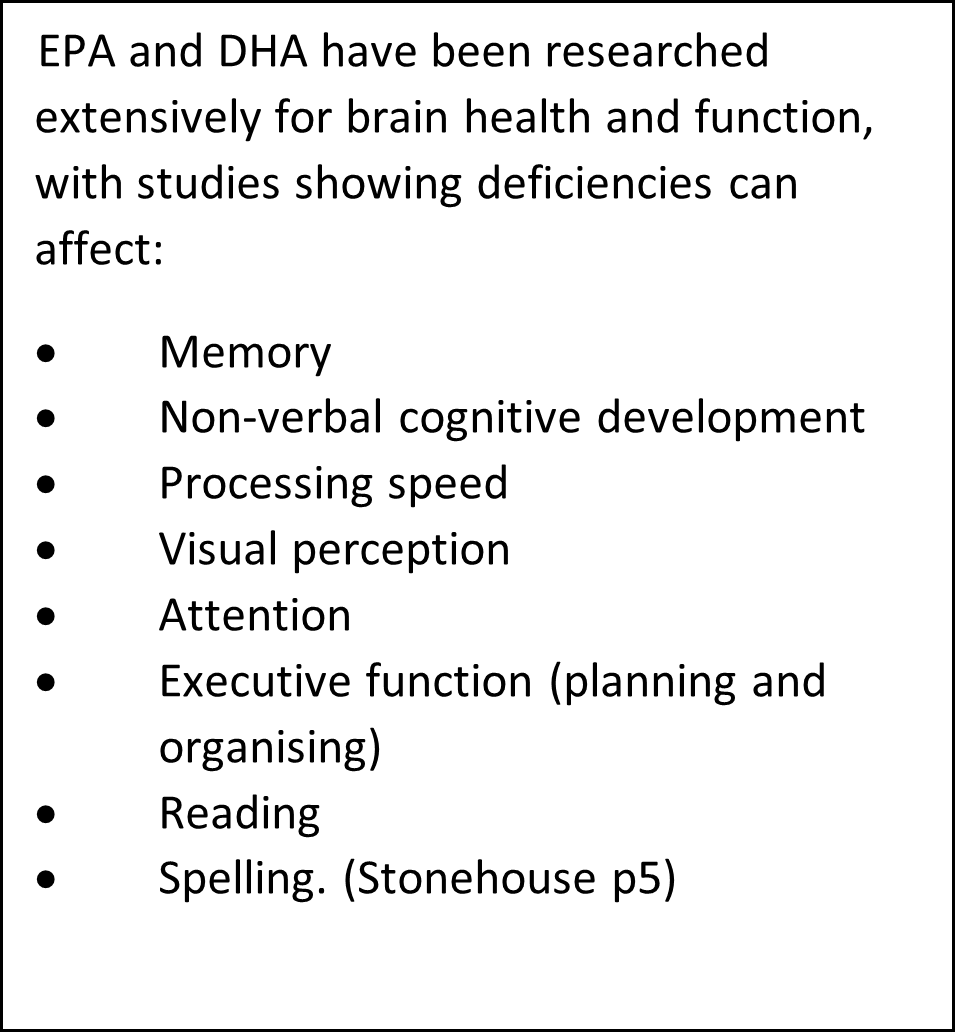
Foods for brain health – discovering how we can support our brain with diet and supplements
Foods for brain health – discovering how we can support our brain with diet and supplements

Our brain is an amazing and mysterious organ. When at our best, we feel sharp, focused and in sync. But as adults, we also have times when we feel mentally sluggish; we may forget where the car keys are or even where we parked the car. But what’s worse, and makes our hearts sink, is when we see our kids’ brains struggle, such as when they constantly battle with reading and writing, or are wired, hyperactive and disruptive in class. It can also be worrying when they retreat inwards from the play around them.
Early social, educational and psychological interventions are always recommended, but how many times is nutrition considered? Should we be asking hat role food and brain supplements play in brain health and whether foods and the nutrients they provide help our brains function as adults and kids?
Unraveling some of the brain’s mysteries
To understand the effect of nutrients and diet on brain health, we first need to understand a little about the brain, its development and its functions.
Our brain starts developing and growing before we are born. By the age of six it is approximately 90% of an adult brain size. However, development and structural changes continue throughout childhood and adolescence. These brain changes directly relate to behaviour (Stiles p1), which can be challenging for many parents, especially during teenage years.
Once it’s at adult size, the brain performs vital functions throughout our lives, including:
- Reasoning
- Learning
- Creativity
- Speech
- Language
- Memory
- Personality
- Planning (movement and sensory)
- Spatial recognition (knowing where our body is in relation to other objects or people). (jawabri p1-2)
To perform all of these complex tasks, the brain uses a chemical and electrical messaging system called neurotransmission. Changes in our ability to think, learn or communicate can occur if any of these messages are unavailable, directed to the wrong place, can’t be received, or overwhelm the system.
Although we may feel let down by our brain sometimes, such as when we can’t remember something important or learn a complex task, it is constantly working. Even when relaxing or sleeping, our brains can still use up to 20% of the energy we get from foods to function. (Tardy page 3-4) So, the age-old comment we often say to our kids, ‘you clearly weren’t thinking!’ is technically not true. They were, just not in a way we wanted them to.
So, how does the brain keep going? Energy and specific nutrients from foods keep this complicated system functioning helping more than 100 billion nerve cells ( neurons) and the messengers ( neurotransmitters) to keep firing, connecting and talking to each other. (Stiles p3) (Tardy p1,4)
‘Since each neuron can make connections with more than 1,000 other neurons, the adult brain is estimated to have more than 60 trillion neuronal connections.’(Stiles p3)
These nutrients also make sure the brain can constantly adapt to change. (Tardy page 3-4) This ability to adapt is called brain plasticity and is crucial in memory formation, learning, behaviour and brain development. It is also involved in how we handle incoming sensory information including sight, smell, hearing and taste. (Aparicio p1,2) So, what are some of these nutrients?
The foods that keep our brains happy and healthy
We all know that a healthy and balanced diet is essential for physical and mental wellbeing at all ages.
Research has shown that increasing fruit and vegetables in our diet can improve mental and emotional wellbeing. After only 14 days of increased fruit and vegetables, 171 young adults had improved vitality and motivation. (Connor 2017 p1) Additionally, other research found ‘that a high level of fruit and vegetable consumption [8-9 servings] appears to be predictive of greater emotional wellbeing on the following day.’ (White p1)
The ideal diet for healthy brain and body will contain a variety of the following (with minimal or no processed and fast foods): (Melzer p3)
- Vegetables
- Fruits
- Legumes (such as lentils and beans)
- Wholegrains
- Nuts and seeds
- Fish, including oily fish
- Other animal-based foods (meat and dairy).
These foods provide macronutrients (protein, carbohydrates and fats) and micronutrients (vitamins and minerals) – all important for healthy brain function. They also provide energy, are necessary for cell membrane function and structure, produce neurotransmitters and hormones, and support our brain’s many processes and functions. (Melzer p1)
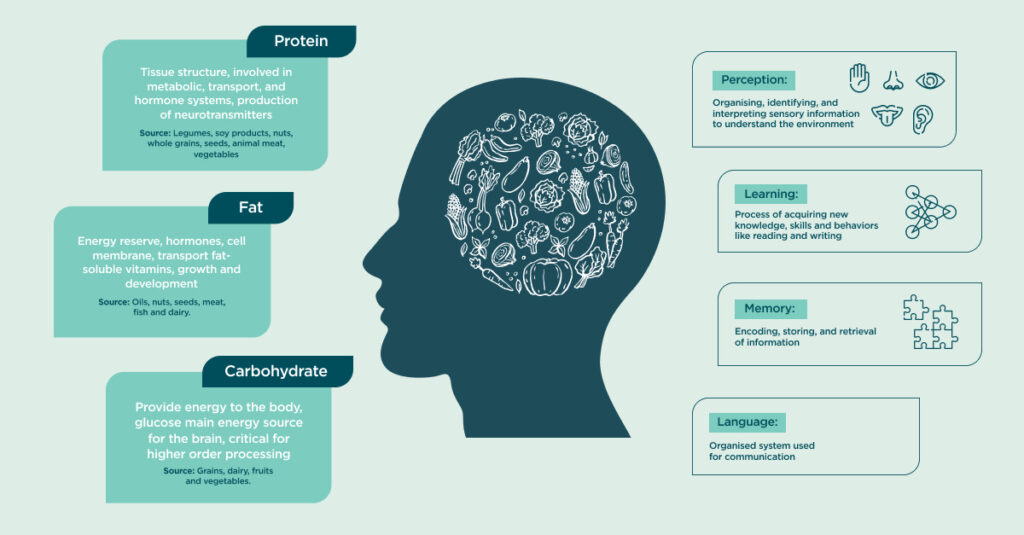
Figure 1: The contribution of macronutrients – foods for brain health (Melzer p1)
There are also specific micronutrients that play essential roles. Many B vitamins, along with vitamins A and E, have been linked to brain health benefits. (Melzer p12) For example, vitamin B6 is necessary to make the neurotransmitters dopamine and serotonin. (Melzer p11) You might know these as the reward and happiness hormones, but they are also essential for learning and memory. (Kuratko 2013 p28) Vitamin B12 levels are linked to memory and attention. (Tardy p19) Read more about nutrients for brain health.
‘Many components of the diet are known to affect cognition and influence learning.’ (Kuratko 2013 p2)
Other key nutrients for brain structure, function and development are polyunsaturated fatty acids or PUFAs. These are types of fats (officially called lipids) found in foods such as nuts and seeds (and the oils made from them), leafy green vegetables and fish. More on these later in this article.
Unfortunately, it can be hard to incorporate these wonderful foods into our kid’s bellies on a regular basis. While most parents want their children to eat a variety of healthy foods, it’s not just the frustration of daily dining table battles that matters; alack of essential nutrients may impact our kid’s learning, reading or spelling abilities.
‘Given the importance of academic success to children‘s wellbeing and ultimate success in life, all educational and environmental factors, including improved nutrition, are worthy of consideration for optimization of learning.’ (Kuratko 2013 p26)
But don’t beat yourself up. There are many reasons why kids (and adults) don’t get enough of these valuable nutrients.
Eating healthy for your brain – a cinch or a challenge?
Feeding kids often tops the list of many parents’ daily challenges. With children’s brains still developing, we are acutely aware they need the full spectrum of nutrients. However, trying to meet these expectations can lead to frustration and guilt.
Parenting often equals guilt. Whether it’s guilt about thinking your child is lazy because they won’t complete their schoolwork properly (even though they may actually be struggling and we don’t know), or about feeling bad that they won’t eat what you want them to. Are they just being stubborn?
You’re not alone. Guilt for a parent is not a phenomenon; it’s a common occurrence. One researcher writes that empathy is required to feel guilt. (Rotkirch p3) We feel guilty and frustrated because we care.
And besides, there are many factors why children won’t or can’t eat enough of the important brain foods, including:
- Access to healthy foods (family financial difficulties or lack of nutritional understanding)
- Food choices (we all know vegetables and fish are not always on a child’s list of favourite foods)
- Eating environment and feeding practices
- Neurodevelopmental conditions (such as autism spectrum disorders and ADHD)
- Lack of new food acceptance (some kids have aversions to new foods, which is called neophobia)
- Picky or fussy eaters (not accepting familiar or unfamiliar foods)
- Media exposure (showing unhealthy food choices)
- Sensory sensitivity (sensitive to the feeling of food in their mouth, sometimes seen with learning and behaviour challenges)
- Genetics (our genes can have an impact on our choices and how we use the nutrients). (Scaglione p2, Dovey p 1, Cermak p6, Experimental Biology)
‘Approximately 25% of all children experience eating problems during the early years of life, but this number may rise to as high as 80% in children with developmental difficulties.’ (Nadon p1)
These are only someof the challenges that affect food choices and availability. (Scaglione p2)
Remember that most infants and children are hard-wired to prefer sweet and salty flavours, with bitter flavours found in some vegetables often requiring repeated exposure. This can mean offering the same food to your child up to 15 times before they feel ready to try it, then another 10 to 15 times before they might like it. (Scaglione p 8,11)
So, eating healthily and getting the right amount of nutrients for your brain is not always straightforward, especially for our kids. Although perseverance is key there may be some circumstances where supplementing the diet may be considered or recommended. Let’s dive into the world of PUFAs, where we will discuss their benefits both from foods and supplements.
PUFAs as brain food
PUFAs (polyunsaturated fatty acids)are types of lipids (fats). You might only think of the fat we eat as insulation for our waistlines, ut some of the PUFAs have complex and valuable roles.
The key PUFAs for health are omega fatty acids and in particular, omega-3 and omega-6. Some of these PUFAs are classed as essential, which means we can’t make them, so we must eat them regularly.
‘The brain contains large amounts of fatty acids, 50% of which are PUFAs’ (Denis p2)
The essential omega-3 PUFA is alpha-linolenic acid (ALA). Rich sources of this are flaxseeds, chia seeds, and green leafy vegetables. The essential omega-6 PUFA is linoleic acid (LA) and is found mainly in seeds (for example, sunflower, soybean, corn, canola) and their oils. (Saini p2)
So, will eating these foods improve your brain health? To understand how these PUFAs come alive in the brain we need to dive into some biochemistry.
Omega PUFAs – a quick dive into the biochemistry (simplified)
Omega-3 PUFAs are crucial for brain development and health. However, to get those benefits our body must do some magical transformations.
When we eat essential omega-3 ALA foods, our body enlists groups of enzymes to change their structure. These changes occur over many steps and transform ALA into different PUFAs. After multiple steps, a new type of PUFA emerges called eicosapentaenoic acid (or EPA). If the body keeps going it can also change some of the EPA into docosahexaenoic acid (or DHA). (Assisi p2) EPA and DHA are the superstars in brain health.
The body does the same thing with omega-6 PUFA LA. One of the important emerging PUFAs from its transformation is called gamma-linolenic acid or GLA (see figure 2). (Assisi p2)
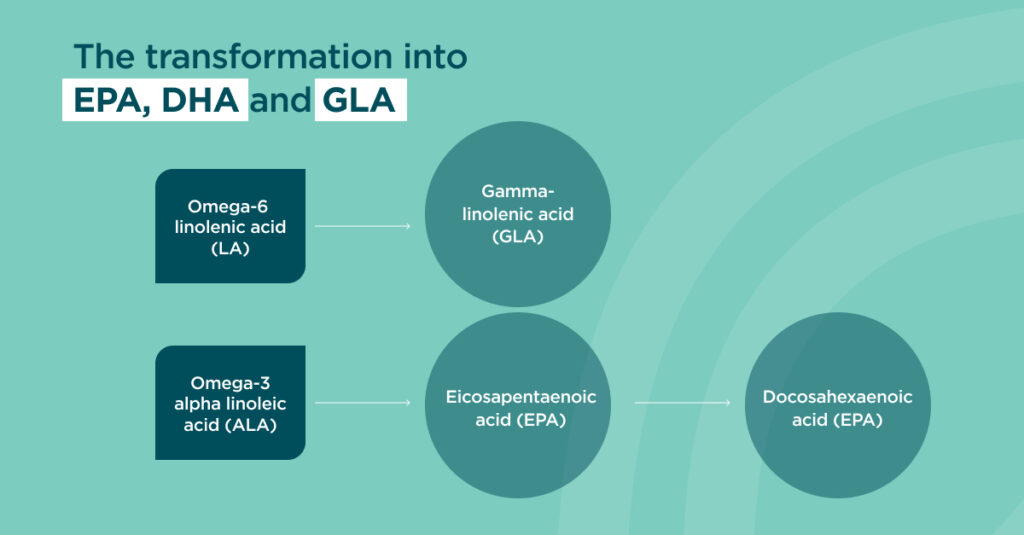
Figure 2: The transformation into EPA, DHA and GLA
Our biochemical story would end here if the body could easily and rapidly change the essential PUFAs into EPA and DHA, but this is not the case as the body is not very efficient at this process. Many factors hinder it, such as low levels of vitamin B1 and B6, magnesium, zinc and vitamin C. (Mallick p9) Additionally, a diet high in processed foods, trans fats and fast foods can also affect these pathways. It also slows down with ageing. (Mallick p9)
So, how do we overcome this dilemma and still get the brain benefits of EPA and DHA? Thankfully, our diet can provide EPA and DHA directly without any changes required by the body.
Plankton and algae in the ocean make EPA and DHA, which fish eat. These fatty acids are then stored in the fatty tissues of the fish (Shahidi p5) which is why oily fish, such as salmon, herring, sardines and mackerel, are the best food sources of EPA and DHA. (Aryal p2) The omega-6 GLA does not miss out, with evening primrose oil being a rich source provided by supplements.
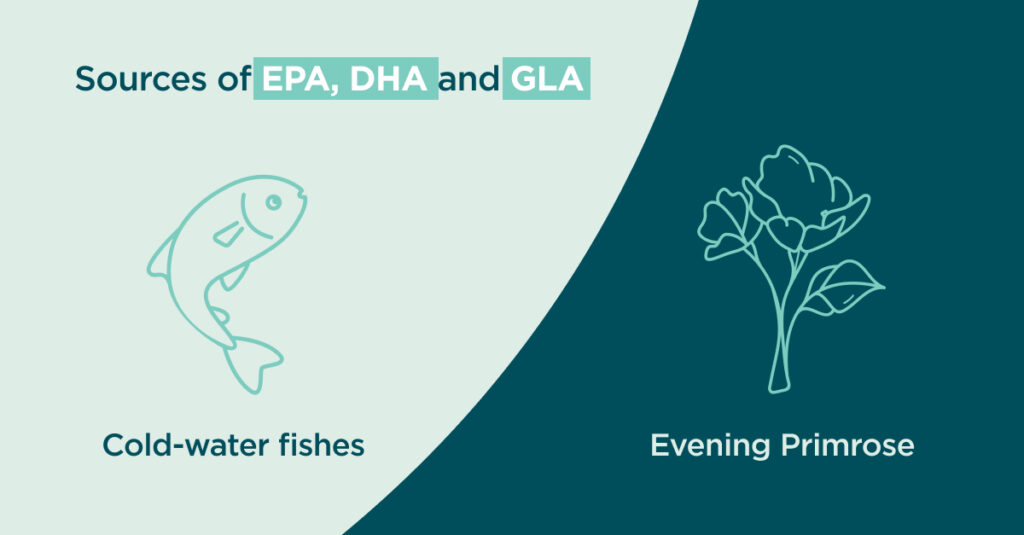
Figure 3: Sources of EPA, DHA and GLA
The benefits of EPA, DHA and GLA in brain health
EPA and DHA influence brain health throughout life. (Eilander p1) DHA is for development and neurological activities, while EPA plays a dominant role in balancing inflammatory pathways. (Mallick p8) Research shows that ongoing deficiencies of these PUFAs can have detrimental effects on our health. (Denis p2)
Together EPA and DHA have many functions, including:
- Brain plasticity (the brain being able to adapt constantly)
- Neuron membrane structure and activity
- Cell messaging and communication
- Production of neurotransmitters (including serotonin and dopamine)
- Protection of neurons
- Reduction in inflammation (important for brain health)
- Energy for brain cells when glucose (sugars) is not available. (Eilander p1, Stonehouse p2, Denis p5, Kuratko 2013 p28, (Mallick p8)
All of these functions can affect how we learn, think, remember and behave. DHA, the dominant omega-3 in the brain, accumulates in the areas of the brain involved in learning and memory (the cerebral cortex and hippocampus), (Stonehouse p2) while GLA is important for reducing inflammation.
‘DHA is the principal omega-3 fatty acid in brain gray matter representing about 15% of all fatty acids in the human frontal cortex.’ (Kuratko 2013 p2)
To get these great brain benefits we need to have an ample supply of EPA and DHA in our diets, and oily fish and children don’t always go together. The same can be said for many adults.
The recommended fish intake for adults is one to two servings per week. (Shahidi p2) However, data shows that a large proportion of adults do not eat enough fish to provide adequate omega-3 levels, with children predicted to have even lower intakes. (Stonehouse p3, Koletzo 2010 p2) Some children with learning and behavioural difficulties also have challenges with their intake of these fatty acids. (Kuratko 2013 p25) So, in some situations, supplementation may be recommended.
PUFA brain supplements – exploring key elements
EPA and DHA have been studied extensively as supplements both singularly and in combination. But there is still some debate on the ideal combinations of the PUFAs for different conditions or situations.
The other PUFA, omega-6 GLA, is a different story. Although it has been researched and shown to have beneficial effects, it is less commonly found in brain supplements because our diet contains large amounts of the omega-6 LA. Compared to our Palaeolithic ancestors, whose ratio of omega-6 to omega-3 was 1:1, the western diet is predicted to be 15-20:1. (Simopoulos p5)
The main problem with having excess omega-6 and reduced levels of omega-3 in the diet is increased inflammation. (Simopoulos p5) If the body has too much omega-6 LA, it can produce lots of the potent inflammatory substance arachidonic acid (AA). (Assisi p2) AA is necessary for normal cell function, but an excess of AA can be damaging and highly inflammatory. (Burdge p13)
However,when GLA is taken as a dietary supplement, it can be changed into a PUFA that can reduce the inflammatory effects of AA and can produce anti-inflammatory substances. (Burdge p13)
Research has also shown that combining GLA with EPA in supplements can reduce the production of AA. EPA competes for the same enzymes that produce AA and blocks this step (see figure 4). (Barham p1)
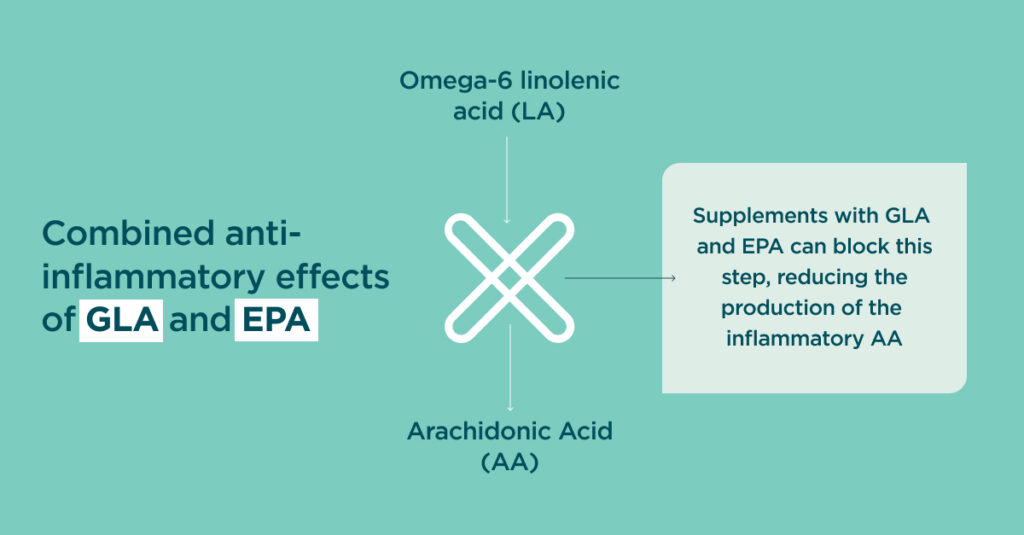
Figure 4: Combined anti-inflammatory effects of GLA and EPA
So, in simple terms, a brain supplement containing EPA, DHA and GLA is worthy of food for thought. Multiple studies have shown that a supplement containing all these PUFAs in a ratio of 9:3:1 (EPA:DHA:GLA) may be beneficial for children with behaviour challenges, and can improve reading and spelling skills. (Koletzo 2010 p3, Richardson 2005, Parletta 2013, Jonson 2017) You can read about more the 9:3:1 PUFA ratio here.
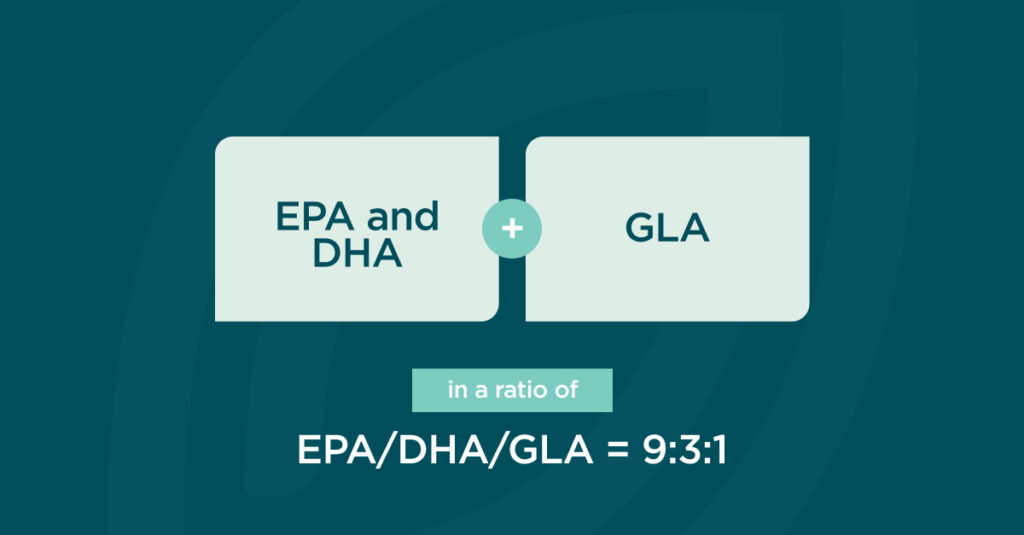
Figure 5: Combined anti-inflammatory effects of GLA and EPA
Foods for brain health and brain supplements
Research shows that several foods and nutrients in our diet can help build strong foundations for brain health across our lifespan and that even small changes (such as extra vegetables or one fish meal a week) may have a positive impact on our health. Thisis encouraging when you are struggling to get these foods into your kids every day. There are also many situations where supplements may be necessary. Whatever you decide is important for you or your children always speak to your healthcare provider to discuss your best options.
References
Aryal S, Hussain S, Drevon CA, et al. Omega-3 fatty acids regulate plasticity in distinct hippocampal glutamatergic synapses. The European journal of neuroscience. 2019;49(1):40-50. https://pubmed.ncbi.nlm.nih.gov/30367533/
Assisi A, Banzi R, Buonocore C, et al. Fish oil and mental health: The role of n-3 long-chain polyunsaturated fatty acids in cognitive development and neurological disorders. Int Clin Psychopharmacol. 2006;21(6):319-36. https://pubmed.ncbi.nlm.nih.gov/17012979/
Barham JB, Edens MB, Fonteh AN, et al. Addition of eicosapentaenoic acid to γ-linolenic acid–supplemented diets prevents serum arachidonic acid accumulation in humans. The Journal of Nutrition. 2000;130(8):1925-31. https://academic.oup.com/jn/article/130/8/1925/4686349
Burdge GC, Calder PC. Introduction to fatty acids and lipids. World Rev Nutr Diet. 2015;112:1-16. https://pubmed.ncbi.nlm.nih.gov/25471798/
Cermak SA, Curtin C, Bandini LG. Food selectivity and sensory sensitivity in children with autism spectrum disorders. J Am Diet Assoc. 2010;110(2):238-46. https://linkinghub.elsevier.com/retrieve/pii/S0002822309018082
Conner TS, Brookie KL, Carr AC, et al. Let them eat fruit! The effect of fruit and vegetable consumption on psychological well-being in young adults: A randomized controlled trial. PLoS One. 2017;12(2):e0171206. https://pubmed.ncbi.nlm.nih.gov/28158239/
Denis I, Potier B, Vancassel S, et al. Omega-3 fatty acids and brain resistance to ageing and stress: Body of evidence and possible mechanisms. Ageing Res Rev. 2013;12(2):579-94. https://pubmed.ncbi.nlm.nih.gov/23395782/
Dovey TM, Staples PA, Gibson EL, et al. Food neophobia and ‘picky/fussy’ eating in children: A review. Appetite. 2008;50(2-3):181-93. https://pubmed.ncbi.nlm.nih.gov/31769273/
Eilander A, Hundscheid DC, Osendarp SJ, et al. Effects of n-3 long chain polyunsaturated fatty acid supplementation on visual and cognitive development throughout childhood: A review of human studies. Prostaglandins Leukot Essent Fatty Acids. 2007;76(4):189-203. https://pubmed.ncbi.nlm.nih.gov/17376662/
Experimental Biology 2017. “Could genetics influence what we like to eat? Understanding the roles of genes in eating behaviors and food preferences could lead to personalized diets that are easier to follow.” ScienceDaily. ScienceDaily, 24 April 2017. www.sciencedaily.com/releases/2017/04/170424084056.htm
Jawabri KH, Sharma S. Physiology, cerebral cortex functions. Statpearls. Treasure Island (FL)2021. https://www.ncbi.nlm.nih.gov/books/NBK538496/
Johnson M, Fransson G, Ostlund S, et al. Omega 3/6 fatty acids for reading in children: A randomized, double-blind, placebo-controlled trial in 9-year-old mainstream schoolchildren in Sweden. J Child Psychol Psychiatry. 2017;58(1):83-93. https://pubmed.ncbi.nlm.nih.gov/27545509/
Koletzko B, Demmelmair H, Schaeffer L, et al. Genetically determined variation in polyunsaturated fatty acid metabolism may result in different dietary requirements. KARGER; 2008. p. 35-49. https://www.karger.com/Article/Abstract/146246
Kuratko CN, Barrett EC, Nelson EB, et al. The relationship of docosahexaenoic acid (DHA) with learning and behavior in healthy children: A review. Nutrients. 2013;5(7):2777-810. http://www.mdpi.com/2072-6643/5/7/2777/pdf
Lauritzen L, Brambilla P, Mazzocchi A, et al. DHA effects in brain development and function. Nutrients. 2016;8(1). https://pubmed.ncbi.nlm.nih.gov/26742060/
Mallick R, Basak S, Duttaroy AK. Docosahexaenoic acid,22:6n-3: Its roles in the structure and function of the brain. Int J Dev Neurosci. 2019;79:21-31. https://www.ncbi.nlm.nih.gov/pubmed/31629800
Mateos-Aparicio P, Rodríguez-Moreno A. The impact of studying brain plasticity. Front Cell Neurosci. 2019;13(66). https://www.frontiersin.org/article/10.3389/fncel.2019.00066
Melzer TM, Manosso LM, Yau SY, et al. In pursuit of healthy aging: Effects of nutrition on brain function. Int J Mol Sci. 2021;22(9). https://pubmed.ncbi.nlm.nih.gov/34068525/
Montgomery P, Burton JR, Sewell RP, et al. Low blood long chain omega-3 fatty acids in UK children are associated with poor cognitive performance and behavior: A cross-sectional analysis from the DOLAB study. PLoS One. 2013;8(6):e66697. https://journals.plos.org/plosone/article?id=10.1371/journal.pone.0066697
Nadon G, Feldman DE, Dunn W, et al. Association of sensory processing and eating problems in children with autism spectrum disorders. Autism Research and Treatment. 2011:541926. https://www.hindawi.com/journals/aurt/2011/541926/
Parletta N, Cooper P, Gent DN, et al. Effects of fish oil supplementation on learning and behaviour of children from Australian indigenous remote community schools: A randomised controlled trial. Prostaglandins Leukot Essent Fatty Acids. 2013;89(2-3):71-9. https://pubmed.ncbi.nlm.nih.gov/23756346/
Richardson AJ, Montgomery P. The Oxford-Durham study: A randomized, controlled trial of dietary supplementation with fatty acids in children with developmental coordination disorder. Pediatrics. 2005;115(5):1360-6. https://pubmed.ncbi.nlm.nih.gov/15867048/
Rotkirch A, Janhunen K. Maternal guilt. Evol Psychol. 2010;8(1):90-106. https://www.ncbi.nlm.nih.gov/pubmed/22947781
Saini RK, Keum YS. Omega-3 and omega-6 polyunsaturated fatty acids: Dietary sources, metabolism, and significance – a review. Life Sci. 2018;203:255-67. https://pubmed.ncbi.nlm.nih.gov/29715470/
Scaglioni S, De Cosmi V, Ciappolino V, et al. Factors influencing children’s eating behaviours. Nutrients. 2018;10(6):706. https://www.mdpi.com/2072-6643/10/6/706
Shahidi F, Ambigaipalan P. Omega-3 polyunsaturated fatty acids and their health benefits. Annu Rev Food Sci Technol. 2018;9:345-81. https://pubmed.ncbi.nlm.nih.gov/29350557/
Simopoulos AP. The importance of the ratio of omega-6/omega-3 essential fatty acids. Biomed Pharmacother. 2002;56(8):365-79. https://pubmed.ncbi.nlm.nih.gov/12442909/
Stiles J, Jernigan TL. The basics of brain development. Neuropsychol Rev. 2010;20(4):327-48. https://link.springer.com/article/10.1007%2Fs11065-010-9148-4
Stonehouse W. Does consumption of lc omega-3 pufa enhance cognitive performance in healthy school-aged children and throughout adulthood? Evidence from clinical trials. Nutrients. 2014;6(7):2730-58. https://www.mdpi.com/2072-6643/6/7/2730
Tardy AL, Pouteau E, Marquez D, et al. Vitamins and minerals for energy, fatigue and cognition: A narrative review of the biochemical and clinical evidence. Nutrients. 2020;12(1). https://pubmed.ncbi.nlm.nih.gov/31963141/
White BA, Horwath CC, Conner TS. Many apples a day keep the blues away–daily experiences of negative and positive affect and food consumption in young adults. Br J Health Psychol. 2013;18(4):782-98. https://pubmed.ncbi.nlm.nih.gov/23347122/
